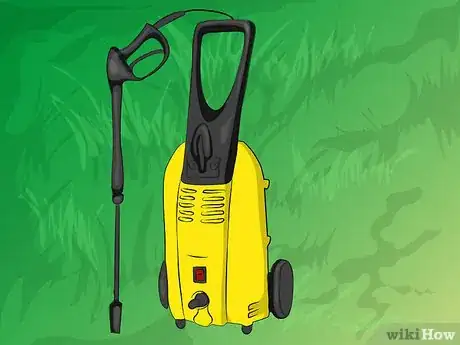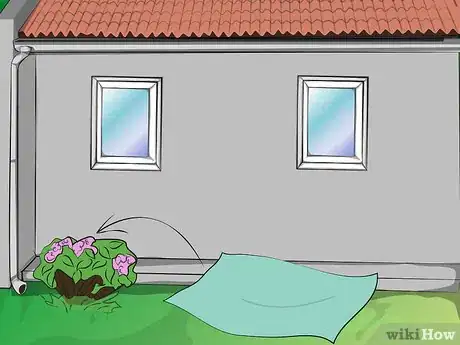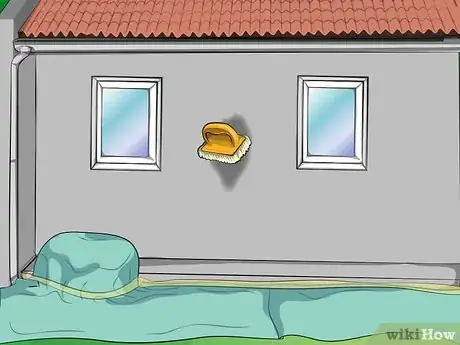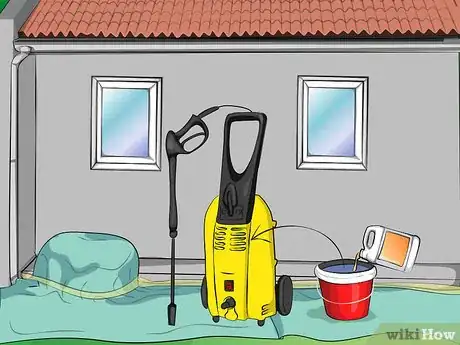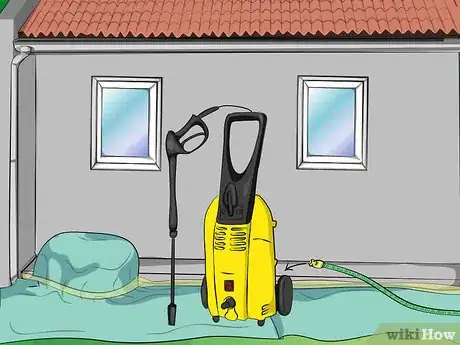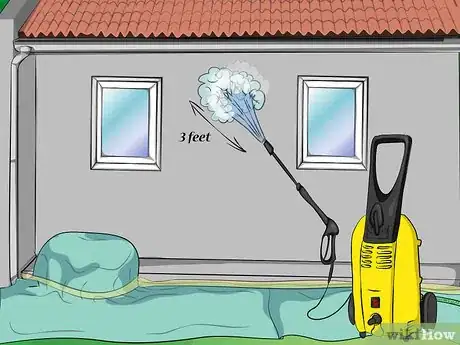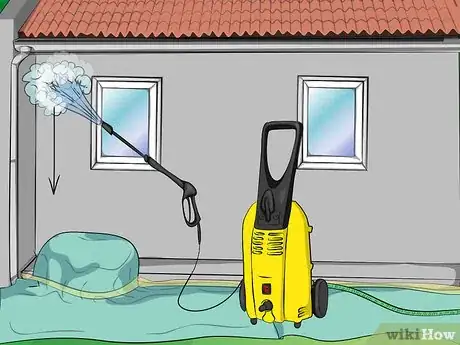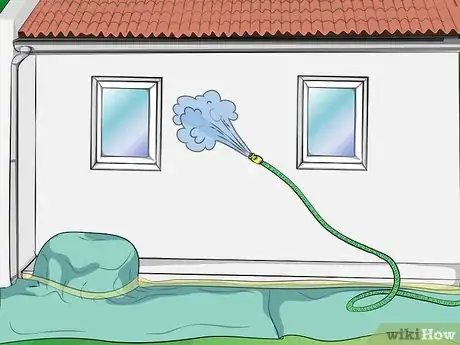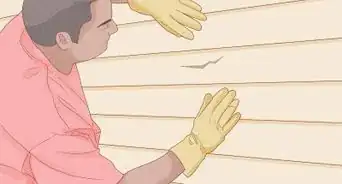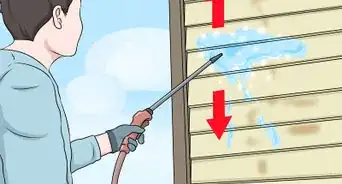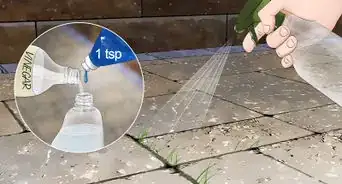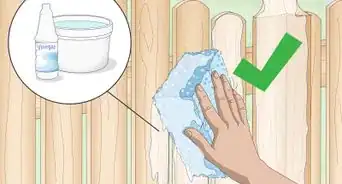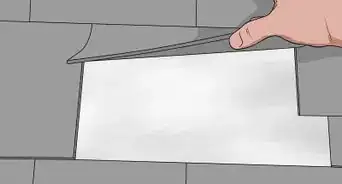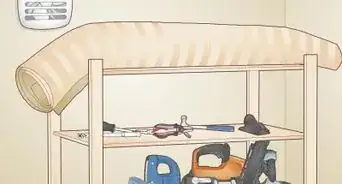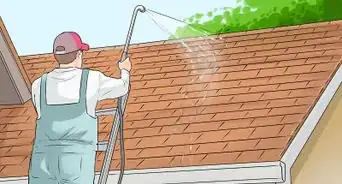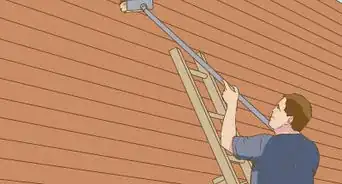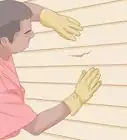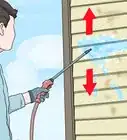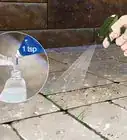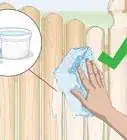This article was co-authored by Varga Gulshani. Varga Gulshani is a Residential Painting Specialist and the Owner of Elegant Painting based in Washington. With more than 16 years of experience, Varga and his team specialize in residential interior painting, exterior painting, and cabinet painting. Varga and the Elegant Painting team have all received background and verification checks.
This article has been viewed 190,880 times.
Pressure washing, also known as power washing, involves using a high-velocity water spray to clean dirt and residue from the exterior of a house. This type of cleaning is a particularly important preparatory step before painting or re-painting your house. A clean surface allows new paint to last longer. You can use pressure-washing equipment on most types of housing material once you learn how to pressure wash a house.
Steps
-
1Choose a pressure washer that is best for the job. Different housing materials can withstand various water pressures. The size, or spray power, ranges from 1,200 to 3,000 pounds per square inch (psi).
- Softer housing materials, such as painted soft-grain wood and aluminum, require a 1,200 to 1,500 psi model to prevent pressure damage. You may need a wide spray nozzle to disperse water pressure for even more vulnerable materials, like stucco.
- Stronger non-painted surfaces, such as vinyl, clean better with a more powerful 2,500 to 3,000 psi model. These models work the fastest.
- Select a pressure washer that has a detergent dispenser if you plan to use a cleaning solution.
-
2Protect you house's exterior fixtures, like lights, landscaping shrubs and plants, from harmful water pressure. Cover with drop cloths or plastic covering and secure with duct tape.[1]
- Move any outdoor furniture away from the house, too.[2]
Advertisement -
3Manually scrub any visible mildew from the surface you are power washing with a brush.[3]
-
4Mix the cleaning solution and fill the pressure washer's detergent dispenser. Combine approximately 1 pound (.455 kilograms) of a non-phosphate concentrated cleaner for every 4 gallons (15.4 liters) of washing water.
-
5
-
6Test how to pressure wash a house by holding the pressure washer nozzle with both hands about 3 feet (121.92 centimeters) from the wall. Move it in closer until you feel the spray is strong enough to remove dirt but not strong enough to cause damage.
-
7Start at the top of the house and move down. Spray roof overhangs, under-hangs and gutters at an approximate 45-degree angle. Move the spray steadily from side to side.[6]
-
8Rinse from the top down with plain water from a garden hose.[7] Allow house siding to dry at least 2 days before painting.
Expert Q&A
-
QuestionDoes pressure washing damage the house?
 Varga GulshaniVarga Gulshani is a Residential Painting Specialist and the Owner of Elegant Painting based in Washington. With more than 16 years of experience, Varga and his team specialize in residential interior painting, exterior painting, and cabinet painting. Varga and the Elegant Painting team have all received background and verification checks.
Varga GulshaniVarga Gulshani is a Residential Painting Specialist and the Owner of Elegant Painting based in Washington. With more than 16 years of experience, Varga and his team specialize in residential interior painting, exterior painting, and cabinet painting. Varga and the Elegant Painting team have all received background and verification checks.
Residential Painting Specialist Not exactly, but it can deal some damage. To avoid problems, move your patio furniture and other items away from the house. Then, seal windows and doors, adding towels under anything that you think might leak.
Not exactly, but it can deal some damage. To avoid problems, move your patio furniture and other items away from the house. Then, seal windows and doors, adding towels under anything that you think might leak. -
QuestionWhat solution do I use?
 Community AnswerYou can use any kind of non-phosphate concentrated cleaner that you want, which can then be mixed with water per the instructions in the article.
Community AnswerYou can use any kind of non-phosphate concentrated cleaner that you want, which can then be mixed with water per the instructions in the article. -
QuestionWhat is the best time of year to pressure wash my home?
 Community AnswerSummer as the water will dry quickly. This will also prevent any lingering water from freezing and possibly damaging your home.
Community AnswerSummer as the water will dry quickly. This will also prevent any lingering water from freezing and possibly damaging your home.
Warnings
- Do not pressure wash your house if the exterior has lead-based paint. Homes painted before 1978 may have lead-based paint. If you are unsure, contact your public health department to determine whether your home contains lead-based paint.⧼thumbs_response⧽
- Use caution when operating a pressure washer. The high-velocity water spray can erode soft-grain woods, a stucco finish or mortar from between bricks if you hold it in one spot for too long. Never get closer than 12 inches from the wall's surface. Do not point it straight up or at windows, window frames, door frames, electrical units or people.⧼thumbs_response⧽
- Never pressure wash hardboard house siding. The moisture will damage the surface.⧼thumbs_response⧽
Things You'll Need
- Pressure washer
- Drop cloths or plastic coverings
- Duct tape
- Scrub brush
- Non-phosphate concentrated cleaner or cleaning solution
- Garden hose
- Water source
- Safety glasses
References
- ↑ https://www.bobvila.com/articles/how-to-pressure-wash-a-house/
- ↑ Varga Gulshani. Residential Painting Specialist. Expert Interview. 12 January 2021.
- ↑ https://www.improvenet.com/a/diy-how-to-power-wash-siding
- ↑ https://www.bobvila.com/articles/how-to-pressure-wash-a-house/
- ↑ Varga Gulshani. Residential Painting Specialist. Expert Interview. 12 January 2021.
- ↑ https://www.familyhandyman.com/painting/how-to-pressure-wash-a-house/
- ↑ https://www.improvenet.com/a/diy-how-to-power-wash-siding
- http://www.hometips.com/diy-how-to/house-siding-power-pressure-wash.html
